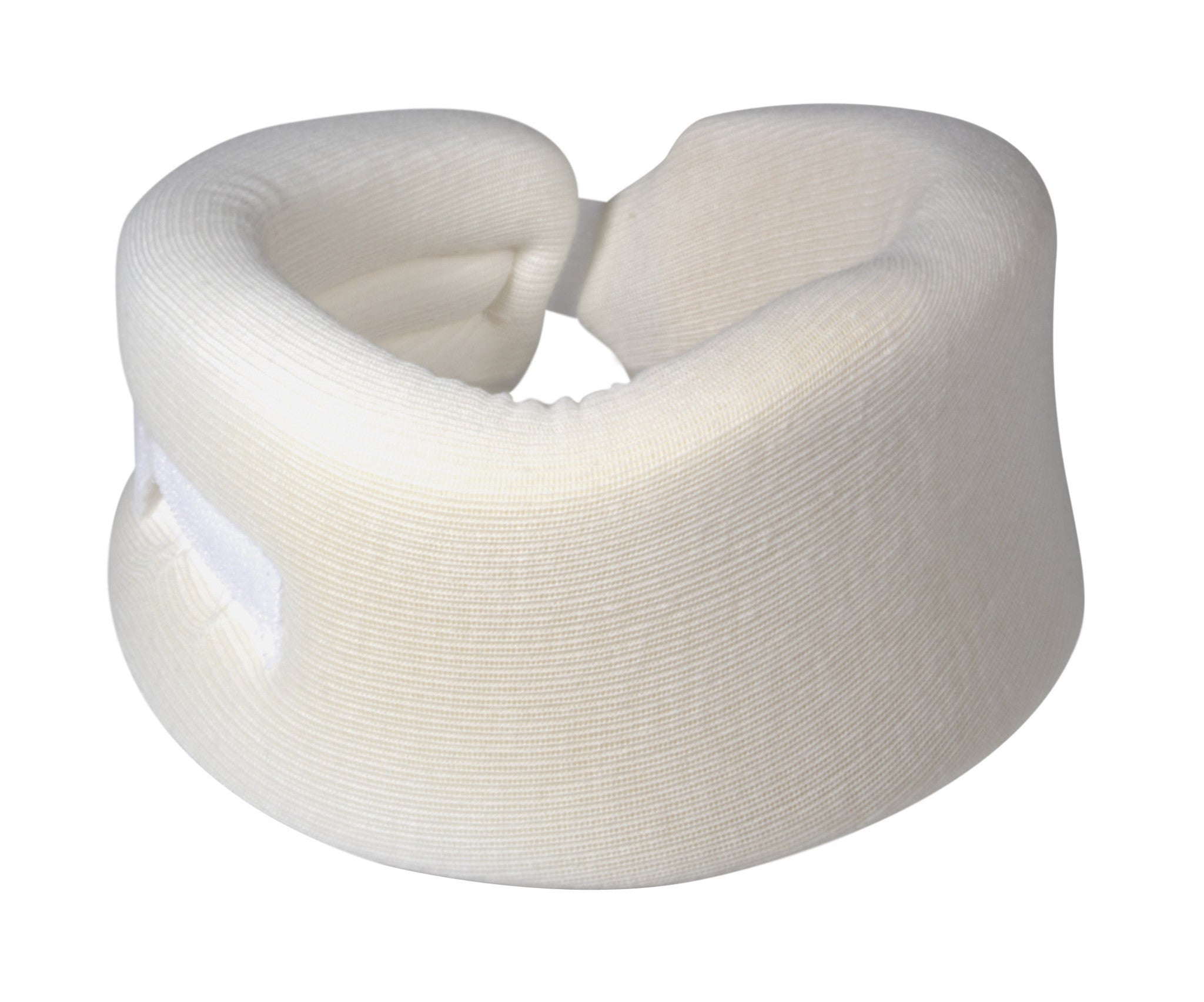Cervical collars, often called neck braces or C collars, are designed to support the head and cervical spine. They’re commonly employed to manage neck injuries, post-surgical recovery, and certain types of neck discomfort.
There are various styles of cervical collars. Which one is appropriate depends on the nature of your neck injury or the cause of your neck pain.
Below we cover the advantages of cervical collars, possible adverse effects—especially with prolonged use—and practical advice for sleeping and bathing while wearing one.

What are cervical collars used for?
The main aim of a cervical collar is to stabilize the neck and spinal cord and to restrict neck and head movement. They are generally intended for temporary use during recovery from an injury, operation, or episode of pain.
Conditions that might call for a cervical collar include:
- Whiplash and trauma. After a car crash or another impact, such as a fall, a cervical collar can shield the neck and help prevent further harm.
- Neck surgery. A cervical collar can limit rotation and side-to-side and forward-backward motion after surgery, helping to protect the surgical site.
- Nerve compression. Occasionally collars are used to lessen pressure on cervical nerves.
- Cervical spondylosis. A collar may give temporary relief from discomfort related to cervical spondylosis, an age-related wear-and-tear condition of neck bones and cartilage.
- General neck pain or stiffness. A cervical collar can reduce strain on neck muscles.
Are there different types?
Cervical collars are available in soft and rigid forms. Soft collars are typically constructed from materials like felt, foam, or rubber. They snugly encircle the neck and sit below the jawline. Clinicians sometimes recommend them for short-term relief of mild to moderate neck pain.
Soft collars usually won’t provide sufficient immobilization for more serious neck injuries.
One study evaluated soft cervical collars in 50 patients with whiplash and found that the collar limited motion by just over 17 percent on average. The investigators concluded that this degree of restriction was insufficient for adequate immobilization to yield clinical benefit.
Hard collars are commonly made from Plexiglas or plastic and restrict head rotation and lateral movement more effectively than soft collars. They often include a chin rest to allow neck muscles to relax.
Rigid neck braces are typically prescribed for severe neck pain, spinal fractures, and traumatic injuries.
Are there side effects to wearing a cervical collar?
While cervical collars can provide short-term support and protection, research has demonstrated that prolonged use may cause neck muscles to weaken and stiffen.
In acute injury situations, some muscle deconditioning may be unavoidable. However, for moderate pain, you might want to limit collar use or discuss alternative approaches with your physician.
In recent years many clinicians have advised against routine collar use for traumatic injuries. This shift is largely due to limited evidence showing that collars improve outcomes and concerns about potential harms.
Safety issues in traumatic cases can include possible airway compromise, raised intracranial pressure, and increased complications.
Tips for wearing a cervical collar
Your healthcare provider will likely give tailored guidance about activities and restrictions while you wear a cervical collar.
As a general rule, when wearing a cervical collar, it’s wise to:
- Move rather than remaining inactive. Gentle activity like walking can help prevent muscle stiffness, which may otherwise slow recovery.
- Practice good posture. Avoid slouching. Keep your back straight, shoulders back, and head aligned so your ears are over your shoulders.
- Avoid sinking into soft, low-seated furniture. This can compromise posture and place extra stress on your neck.
- Refrain from lifting heavy objects. Steer clear of strenuous exercise, running, and other high-impact activities.
- Wear your collar as instructed, removing it only for cleaning or as directed by your clinician.
- Ensure a proper fit that’s snug but comfortable. A collar that’s too loose won’t provide needed support and may worsen pain; if it’s too tight it can chafe and create blisters.
How to sleep with a cervical collar
Tips for sleeping while wearing a cervical collar include:
- Use a supportive mattress. Excessively soft beds may not support your neck adequately.
- Keep your neck in a neutral alignment—avoid bending it forward, backward, or sideways.
- Avoid twisted sleeping positions; maintain alignment between your neck and torso.
- Sleeping on your back with a thin pillow is often best. Multiple pillows can increase neck strain.
- To get out of bed, roll gently onto your side first, then swing your legs over the edge and push up with your arms.
How to bathe with a cervical collar
Bathing is generally easier than showering when you’re wearing a cervical collar.
You may bathe normally but it’s important to keep the collar dry and away from water. Wrapping the collar in plastic can help protect it from moisture.
If you choose to shower, a handheld showerhead can reduce the need to bend or move your neck.
How to clean a cervical collar
Daily cleaning of your collar is important to prevent bacterial buildup. Failure to clean it regularly may lead to skin irritation from bacterial growth.
Most soft collars can be washed in warm water with mild soap and then air-dried. Avoid harsh detergents, strong soaps, or bleach, which can provoke skin reactions.
Hard collars can be cleaned by replacing soiled padding and rinsing the anterior and posterior panels.
When you reapply your cervical collar, make sure it fits correctly. A collar that’s too loose may rub and cause pressure sores and irritation.
How long do you need to wear a cervical collar?
The duration of collar use varies based on your diagnosis.
For non-traumatic, moderate neck pain, it’s commonly advised not to wear a cervical collar for longer than about a week. Prolonged use risks muscle stiffening and weakening.
If the collar is prescribed for a significant injury or acute pain, consult your physician about the appropriate length of wear.
The bottom line
Cervical collars are used to stabilize and protect the neck and cervical spine. They’re typically applied for neck injuries, postoperative protection, and certain types of neck pain.
Collars come in soft and rigid forms. Soft collars are often used for mild to moderate pain, while rigid collars are reserved for severe pain, spinal fractures, and traumatic injuries.
Although cervical collars can be beneficial short term, evidence indicates that extended use may result in neck muscle weakening and stiffness.


















Leave a Reply
You must be logged in to post a comment.